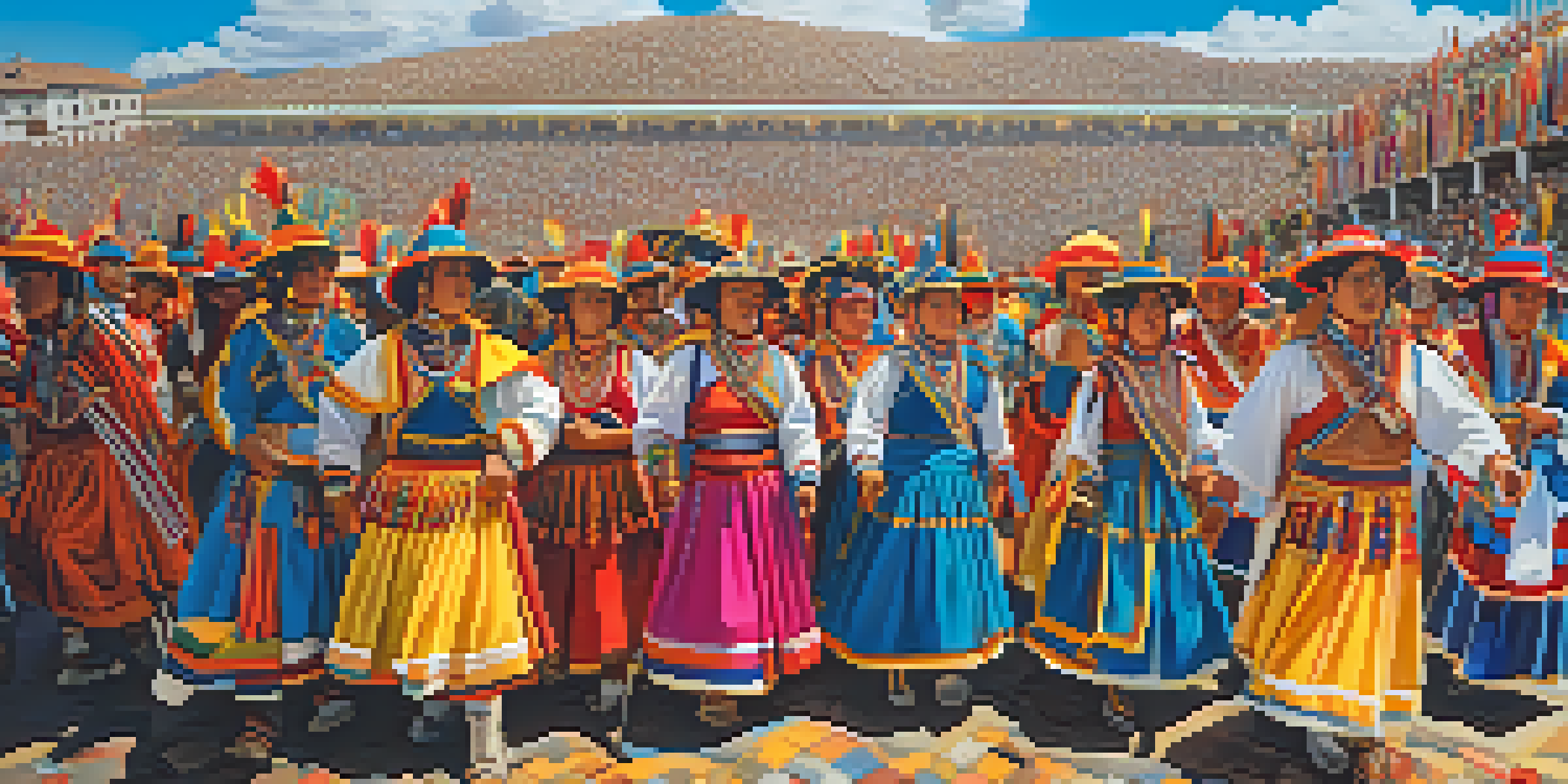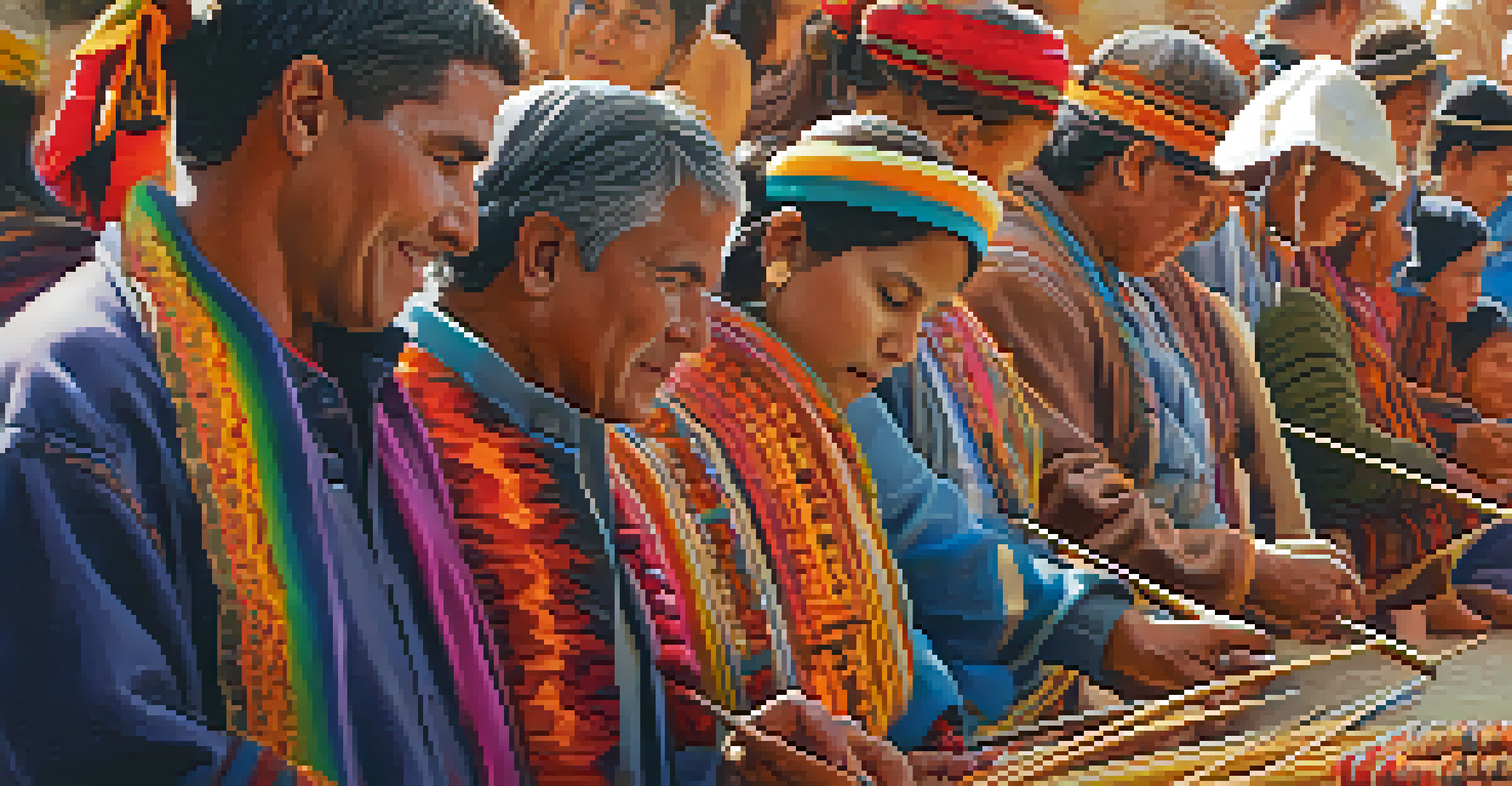The Role of Festivals in Peru's Cultural Exchange Programs

Understanding Cultural Exchange in Peru's Festivals
Cultural exchange is a vital aspect of Peru's identity, and festivals serve as a vibrant platform for this interaction. These celebrations attract visitors from around the globe, creating opportunities for sharing traditions, stories, and cuisines. In essence, they are a melting pot of cultures, where locals and tourists alike can bond over music, dance, and art.
Cultural exchange is not just about sharing traditions; it's about forging connections that transcend borders and foster mutual understanding.
For example, the Inti Raymi festival, dedicated to the Incan sun god, showcases ancient rituals and attracts thousands. This event not only promotes local heritage but also invites international audiences to experience Peru's rich history firsthand. Such interactions help break down cultural barriers and foster mutual understanding among diverse communities.
Moreover, festivals often feature workshops and educational programs that encourage participants to learn about each other's customs. By engaging in traditional crafts or culinary practices, attendees can appreciate the nuances of Peruvian culture, contributing to a deeper cultural exchange that goes beyond mere observation.
The Economic Benefits of Cultural Exchange Through Festivals
Festivals in Peru are not just about celebration; they also have significant economic implications. By attracting tourists, these events generate revenue for local businesses, creating jobs and supporting artisans. This economic boost can be particularly impactful in rural areas, where festivals may be one of the few opportunities for income.

Take, for instance, the Fiesta de la Candelaria in Puno, which sees thousands of visitors each year. This influx of tourists benefits hotels, restaurants, and local craftspeople, showcasing the interdependence between cultural exchange and economic growth. As a result, communities are incentivized to preserve their cultural heritage, knowing it can lead to financial opportunities.
Cultural Exchange Through Festivals
Peru's festivals serve as vibrant platforms for cultural exchange, promoting mutual understanding among locals and international visitors.
Furthermore, the economic benefits of these festivals can encourage sustainability efforts. When communities see the financial value in preserving their culture, they are more likely to engage in practices that protect their traditions and environment, ensuring that future generations can continue to celebrate their heritage.
Promoting Global Awareness Through Local Festivities
Festivals in Peru play a crucial role in promoting global awareness of local issues and traditions. As international visitors experience these events, they gain insights into the challenges and triumphs of the Peruvian people. This exposure can foster a greater understanding of global issues, such as climate change and cultural preservation.
Festivals are the heartbeat of a community, where every drumbeat and dance step tells a story of culture, resilience, and unity.
For example, the Festival de la Primavera in Trujillo highlights the region’s rich agricultural practices and the importance of environmental stewardship. By participating in such events, attendees can learn about sustainable farming techniques and the impact of climate change on local communities. This knowledge encourages visitors to advocate for environmental issues once they return home.
Additionally, as these festivals often address themes of social justice or cultural identity, they serve as a platform for dialogue. Participants can engage in conversations that promote empathy and awareness, bridging gaps between different cultures and encouraging collaborative solutions to global challenges.
The Role of Technology in Enhancing Festival Experiences
In today’s digital age, technology plays a pivotal role in enhancing the festival experience in Peru. Social media platforms allow for real-time sharing of moments, drawing in a larger audience and promoting cultural exchange beyond geographical boundaries. This connectivity fosters a sense of global community among festival-goers and those who wish to participate from afar.
Moreover, many festivals are now incorporating digital tools to engage participants actively. Virtual reality experiences, live streaming, and interactive apps can enhance the understanding of cultural practices for both on-site attendees and those tuning in remotely. This technological integration not only broadens the audience but also enriches the learning experience.
Economic Impact of Festivals
These celebrations generate significant revenue for local businesses, creating jobs and incentivizing the preservation of cultural heritage.
However, it’s essential to strike a balance between digital engagement and authentic experiences. While technology can enhance accessibility, it should not overshadow the genuine interactions that occur during these celebrations. Ultimately, the goal is to foster a sense of connection that celebrates Peru's rich cultural heritage while embracing modern advancements.
Festivals as a Means of Preserving Indigenous Cultures
Peru is home to numerous indigenous cultures, each with its own unique traditions and customs. Festivals serve as a vital means of preserving these cultural identities, providing a platform for indigenous communities to showcase their heritage. Through music, dance, and storytelling, these celebrations keep ancient practices alive and relevant in the modern world.
For instance, the Qoyllur Rit'i festival blends Christian and indigenous beliefs, illustrating the rich tapestry of Peru's cultural landscape. By participating in these festivals, indigenous peoples can educate others about their history and values, ensuring that their voices are heard and respected. This visibility is crucial for cultural preservation.
Additionally, these festivals encourage younger generations to engage with their roots. By witnessing and participating in traditional celebrations, youth are more likely to appreciate their heritage and continue the practices that define their culture. This intergenerational exchange is essential for the survival of indigenous traditions in an ever-changing world.
Building Community Through Shared Festival Experiences
Festivals in Peru are not just about cultural exchange; they also play a significant role in building community. These events often bring together individuals from diverse backgrounds, fostering friendships and connections that transcend cultural differences. The joy of celebration can create a sense of belonging and unity among participants.
For example, the Virgen de la Candelaria festival not only attracts tourists but also strengthens local bonds. As residents work together to organize events, from parades to traditional performances, they cultivate a spirit of collaboration and teamwork. This sense of community can be empowering, encouraging individuals to contribute actively to their neighborhoods.
Future of Festivals and Technology
As technology advances, the potential for global participation in Peruvian festivals will enhance cultural exchange and broaden audience engagement.
Moreover, shared experiences during festivals can lead to the creation of lasting memories. These moments help forge connections that transform strangers into friends, creating a supportive network within the community. Ultimately, festivals remind everyone of the importance of coming together to celebrate life, culture, and shared values.
The Future of Cultural Exchange Through Peruvian Festivals
As Peru continues to embrace its rich cultural heritage, the future of festivals looks promising for cultural exchange. With increasing globalization, these events will likely evolve to include diverse influences while retaining their traditional roots. This adaptability can help keep festivals relevant and engaging for future generations.
The integration of sustainable practices and community involvement will be crucial in shaping the future of these celebrations. By prioritizing environmental consciousness and inclusivity, festivals can become even more impactful in promoting cultural exchange. This commitment can ensure that festivals not only celebrate the past but also pave the way for a more sustainable future.

Furthermore, as technology advances, the potential for global participation in Peruvian festivals will only grow. Virtual experiences can allow people from all corners of the world to engage with Peruvian culture, fostering understanding and appreciation. The future of cultural exchange through festivals is bright, offering endless possibilities for connection and learning.